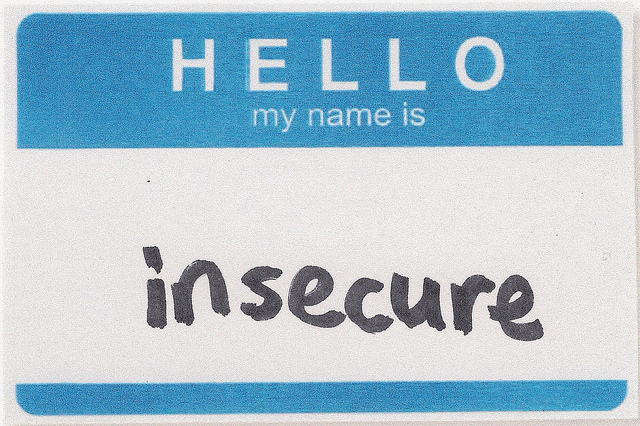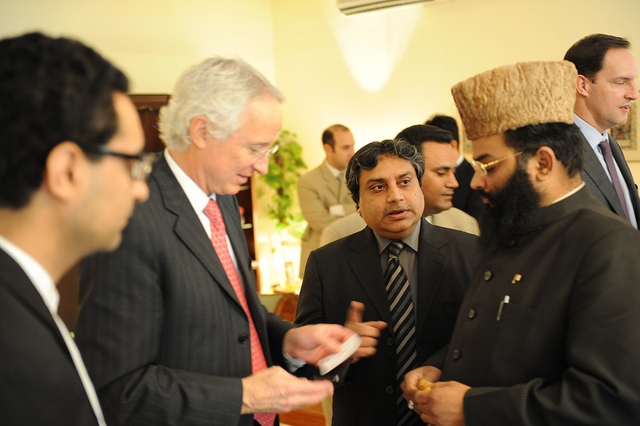
Look like a pro at networking activities, even if you feel like a fish out of water.
Follow these tips and you’ll bolster your confidence and meet interesting people. I promise because I have been where you are. This is your step-by-step guide to pain-free networking.
This is the first networking activity where your rookie status could show up. Pay attention.
Greet the person who signs you into the event. This person probably knows everybody and can be a good resource later. Make a mental note of his/her name.
Ask if they’re expecting a good turnout today. This will help you assess whether this crowd is a group that’s active with well-attended events. If it’s not, you needn’t come back.
If they don’t already have a name tag for you, print your first name in large letters on the blank name tag they give you. In smaller print below, write your last name and company name if it fits.
ALERT: Now place the name tag on right side of your chest (from your perspective). Do NOT place it on the left side near your heart. That is a rookie mistake.
Why? When you shake hands with people, it’s easier for them to read your name tag if it’s near the arm you use to shake hands (which is always the right hand, even for lefties). Make it easy for others to see your name.
If you are handed a name tag on a lanyard—one of those cords that goes around your neck—shorten the cord by tying a knot in it so your name tag is not down by your belly. Ladies, try to make sure it’s not smack dab between your boobs, because that means people will be staring at your chest. Gentlemen, be sure your name tag isn’t hanging too low. Be smart, people.
While you’re still at the check-in area, ask if they have a list of registered attendees. If so, grab one along with any other fliers or information provided. Take a few moments to step away from the check-in and look at the list of attendees. Make note of who you want to meet. You can do this because you’ve already done your planning for this event. See Networking #1.
Need more? Tips for Shy People
Set up your business card process. You did remember to bring business cards with you, didn’t you? This is a networking event. Business cards are expected. More on business cards shortly.
It’s easiest if you have two pockets available, such as in a jacket or pants. Put your business cards in one pocket. Leave the other pocket free so you can put business cards you receive in that pocket.
Do not rifle through your purse or wallet to get out your business card. When you dress for the event, make sure you have pockets. Do not pull a business card from your back pocket. That’s gauche.
It’s time to begin your networking activities—meeting people, asking questions and more. Take a deep breath or two to calm yourself. Check the following:
Scan the room for someone you know. If you’re going to an event where you don’t expect to know anyone, invite a friend to join you. Pay their way.
I was recently invited to a conference of about 500 people, none of whom I expected to know. I looked at the association’s member list, saw a woman I had talked with before, and arranged to meet her at the event. Crowds are far less intimidating when you have a buddy, a friend, or a wing man with you.
Remember to shake hands with everyone you meet. A firm grip is expected, but not one that shows you’re into arm wrestling.
Let’s assume you don’t know anyone at the event. Look for other solitary people. They are probably feeling just as awkward and out of place as you are. Then use humor to break the ice.
This sounds corny, but it works. I’ll approach someone who’s in the corner or leaning against a wall and say, “Hi, do you mind sharing your corner/wall with me?” That generally gets a chuckle and allows us to introduce ourselves and talk about why we’re there and who we want to meet.
After a few minutes of this, I’ll say, “Well, partner, are you ready to step into the fray and see who we can meet?” Now that you two are buds, you’ll both feel more confident moving on together.
Look for people who are smiling and chatting comfortably with others. If you find two people chatting, observe their body positions. Are they close to each other and obviously in a personal conversation? Or are they standing in a V, chatting but also looking around the room?
You don’t want to intrude into a personal conversation (see personal space below), but people in the V position have left an opening for others to join them.
You and your new friend approach those two and introduce yourselves. Say something like, “Hi, I’m George Sands and this is Adam Ant. We’ve never been to this event before, but it looks like you two might be veterans. What draws you to this group/event?”
The other two will introduce themselves and take on the burden of creating a conversation with you.

A group of 3 or more people poses questions about whether you should join them. If they’re in a tight circle and their feet are pointing toward the middle of the circle, go elsewhere. This indicates they’re a closed group.
If someone you want to meet is in that group, wait a few minutes, and the group will probably break up. That’s your chance to wander over and introduce yourself to your target.
If a group of 3 or more is in a loose gathering, with some feet pointing away from the center of the circle, you could approach the group. Stand off to the side for a minute, and listen to the conversation for a place where you can join in.
Personal space is something you’re aware of, but may never have heard it fully defined. You definitely do not want to violate someone’s space.
Think about that person who always gets in your face—literally. Right up close. And you automatically back up, because said dude is invading your personal space.
American anthropologist Edward Hall defined personal space in the 1950s. Here is how your space breaks down.
Intimate space—up to 18 inches. Only family, close friends, and pets are allowed here.
Personal space—anywhere from 18 inches to 4 feet. Friends and acquaintances are allowed here.
Social space—from 4 to 12 feet. Anybody, including strangers, can tread here.
Think about what happens when you get on an elevator. People automatically move to the sides of the elevator car, putting space between themselves and others.
During your networking activities, definitely be aware of how close you stand to someone. If you’re moving toward someone and they start backing away, don’t continue to move closer. They are automatically protecting their space.
These distances are what works in the US. If you’re networking in certain Asian countries or with natives of those countries, you’ll quickly realize they are comfortable with much tighter spaces than we are in the U.S.
Immediately banish the following thoughts from your brain.
The focus of your networking activities is to meet interesting people that you might want to talk with again later. To follow up, you need their business cards, and the same for them to follow up with you. The purpose of networking is NOT to collect as many business cards as you can. Period.

Ambassador Munter exchanges business cards at December 12 reception for religious leaders in Pakistan. US Embassy Pakistan
When I’m networking, I’ll usually introduce myself to another person like this. For this example, I’ll call that person Jeremiah. Assuming I can read his name tag, I’ll say:
“Hi, Jeremiah, I’m Pam Scott with Mentor Loft. I see that you work with ACME Industries.” Then I’ll immediately follow with one of these.
“What brings you to this event today?”
“What do you do at ACME?”
“What’s happening in your world?”
That may sound a bit flip to some folks, but I’ve found it works well if delivered lightly and with a smile on your face.
If I can’t read his name tag, I’ll say, “Hi, I’m Pam Scott with MentorLoft. I can’t read your name tag. Would you mind introducing yourself?”
I do NOT shove my business card in Jeremiah’s face.
After a few minutes of conversation, I’ve decided I like Jeremiah and would like his business card. I’ll say:
“I’ve really enjoyed talking with you. Can I get your card?”
“I can introduce you to someone at (Jeremiah’s targeted company). Please give me your card.”
“I’d like to continue our conversation later. Can I have one of your cards so I can follow up?”
As Jeremiah hands me his card, I hand him mine.
If I’m talking to someone I view as a potential client—particularly if that person is higher ranking than me, I might take this approach.
“Would it be OK if I gave you my card?”
“Can I give you my card? I’d love to follow up with you later. I think we can help each other.”
I’ve never had anyone tell me they didn’t want my card. If someone does tell you that, move on. That individual isn’t worth your time.
One manager told me he automatically hands over his card, which leads others to do the same. This is particularly true if you’re sitting at a table for 8 or more.
Please do not just stuff someone’s card in the appropriate pocket. Take a minute or two to look at it and comment on the design or where his office is or something.
Then turn it over and make notes on the back. “Follow up with Jeremiah re: contact at XYZ Corp.”
Or “has twin daughters, wife expecting their son.” Also, always note where and when you met Jeremiah, such as “Metro Chamber, March 2107 meeting.”
We’ve gotten through more than 1,800 words, and we’re not even at the food yet!
In my next blog on networking activities, we’ll tackle how to handle those fear-inducing tables for eight. Which bread plate is mine? is a common refrain. We’ll also explore how to make introductions. We’ll share gracious exit lines and how to enjoy feeling like a pro at your networking activities.
© Pam Scott, MentorLoft.com, 2017